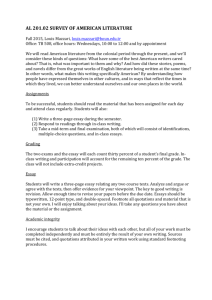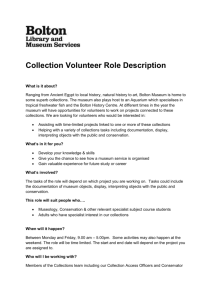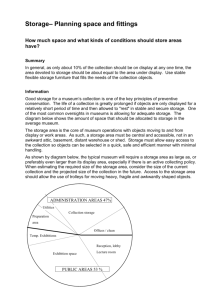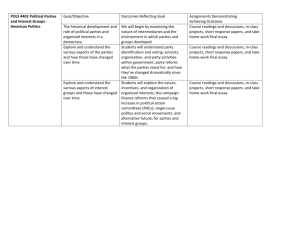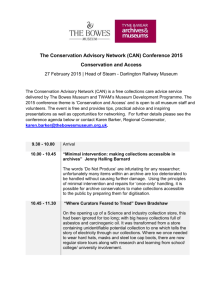Collections Management
advertisement
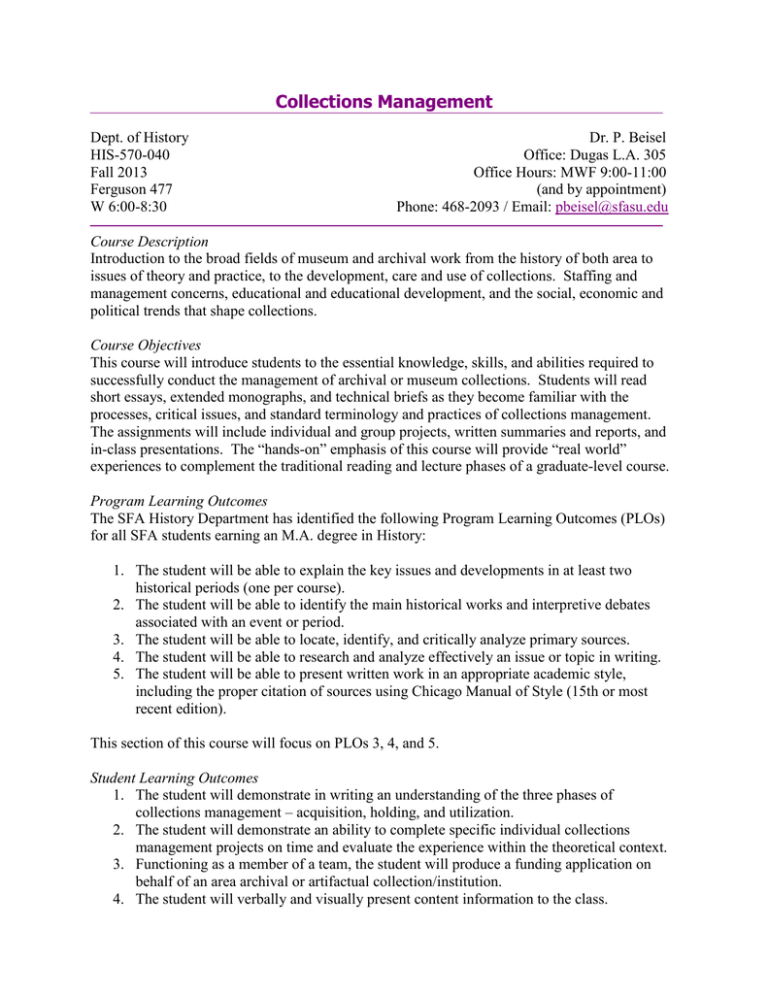
Collections Management Dept. of History HIS-570-040 Fall 2013 Ferguson 477 W 6:00-8:30 Dr. P. Beisel Office: Dugas L.A. 305 Office Hours: MWF 9:00-11:00 (and by appointment) Phone: 468-2093 / Email: pbeisel@sfasu.edu Course Description Introduction to the broad fields of museum and archival work from the history of both area to issues of theory and practice, to the development, care and use of collections. Staffing and management concerns, educational and educational development, and the social, economic and political trends that shape collections. Course Objectives This course will introduce students to the essential knowledge, skills, and abilities required to successfully conduct the management of archival or museum collections. Students will read short essays, extended monographs, and technical briefs as they become familiar with the processes, critical issues, and standard terminology and practices of collections management. The assignments will include individual and group projects, written summaries and reports, and in-class presentations. The “hands-on” emphasis of this course will provide “real world” experiences to complement the traditional reading and lecture phases of a graduate-level course. Program Learning Outcomes The SFA History Department has identified the following Program Learning Outcomes (PLOs) for all SFA students earning an M.A. degree in History: 1. The student will be able to explain the key issues and developments in at least two historical periods (one per course). 2. The student will be able to identify the main historical works and interpretive debates associated with an event or period. 3. The student will be able to locate, identify, and critically analyze primary sources. 4. The student will be able to research and analyze effectively an issue or topic in writing. 5. The student will be able to present written work in an appropriate academic style, including the proper citation of sources using Chicago Manual of Style (15th or most recent edition). This section of this course will focus on PLOs 3, 4, and 5. Student Learning Outcomes 1. The student will demonstrate in writing an understanding of the three phases of collections management – acquisition, holding, and utilization. 2. The student will demonstrate an ability to complete specific individual collections management projects on time and evaluate the experience within the theoretical context. 3. Functioning as a member of a team, the student will produce a funding application on behalf of an area archival or artifactual collection/institution. 4. The student will verbally and visually present content information to the class. Required Books Dearstyne, Bruce W. Managing Historical Records Programs: A Guide for Historical Agencies. Walnut Creek, CA: AltaMira Press, 2000. Reibel, Daniel B. Registration Methods for the Small Museum. 4th edition. Walnut Creek, CA: AltaMira Press, 2008. Wolf, Thomas. Managing a Nonprofit Organization. Updated Twenty-First-Century Edition. Revised and Updated. New York: Free Press, 2012. Grading Scale Assignment (due date) Points Weight In-class participation Three-page Review (9/4) Three-page Review (9/25) Three-page Review (10/23) Three-page Review [lowest of four dropped] (11/20) Individual Conservation Presentation (10/2) Individual Archival Project (10/9) Individual Museum Project (11/13) Group Project (others & 12/4 – final submission) Ten-page (body) Selected Issue Essay (11/13 & 12/11) Total 16 8 8 8 8 25 25 25 35 50 200 8% 4% 4% 4% 4% 12.5% 12.5% 12.5% 17.5% 25% 100% The final grade in the course is determined by the total number of points earned on participation, summaries, presentations, and projects weighted according to the percentages listed above. Students are responsible for reading all instructions, links, study guides, and relevant information posted on D2L. Successful participation includes advance reading, timely submission of assignments, and meaningful contributions to class discussions. Attendance Policy Students are expected to attend all classes. Three-page summaries Write a three-page, double-spaced, 1” margin, left-aligned, 12 point font review of three of the selected sets of readings. If you write the fourth review, the lowest grade will be dropped. Your report should have your name and date on the first page (only) and page numbers (only) on each subsequent page. The bibliographic information, in proper Chicago Manual of Style format, should be listed on the first page of the review following your name and date. Your name, the date, and citation information should be single-spaced. If you have any questions about the format please reference the reviews published in scholarly journals such as the East Texas Historical Journal, The Public Historian, the Southwestern Historical Quarterly, or the American Historical Review. The summary should not only include an overview of the author’s thesis and supporting evidence for each selection, but also a consideration of its intended audience and potential future use. Your summary should be a cohesive essay with evidence from all readings rather than a conglomeration of multiple reviews. You may use either properly formatted footnote or parenthetical references (no endnotes). The due dates are noted on the class schedule. Each assignment is due in hardcopy at the beginning of the class session and is worth a total of eight points. 2 Individual Conservation Presentation Each student will prepare and present an in-class report (15 minutes, strictly enforced) on a particular individual conservation problem and its preventative measures and solutions. Your presentation must be presented to the class using PowerPoint (a minimum of five slides including title slide). It should be saved as a PowerPoint Show for access in the classroom. Each student will provide a hardcopy of the presentation to the full class (be sure to include your name, the date, and topic). The assignment is worth twenty-five points. Pests/Insects – Dust/Dirt – Light – Water/Humidity – Temperature – Paper (de-acidifying, repair, flattening, cleaning) – Leather and Stuffed Specimens – Fabric (cotton, wool, silk) – Precious metals – Industrial metals – Wooden artifacts and Furniture – Maps/drawings – Mold/Fungus – Weapons/Hazardous Materials – Storage Materials (folders, boxes, envelopes) – Transportation (inside & outside of institution) – Fire – Paintings – Books – To get a jumpstart check the American Association for State and Local History, the American Institute for Conservation of Historic and Artistic Works (AIC), the Benson Ford Research Center, the Canadian Conservation Institute, the Getty Conservation Institute, the Journal of Conservation and Museum Studies, the National Center for Preservation Training and Technology, the National Park Service (Harpers Ferry Center & Museum Management Program), the Northeast Document Conservation Center, the Smithsonian Institution (Museum Conservation Institute). Don’t forget monographs and articles as well! Individual Archival Project Each student will work a minimum of twenty hours (watch out, you might get hooked!) in the East Texas Research Center (ETRC), Steen Library. The ETRC’s hours are 8:00-5:00 M-F. Saturday hours are by pre-arrangement only. Director Linda Reynolds will assign you to a specific collection/task(s). The activities may include rehousing documents and photographs, creating or expanding finding aids, cleaning and repairing, and digitizing materials. Each student will conduct an insect survey and record temperature and humidity levels each day at the ETRC. The dates for this project will be August 28th – October 9th. You will need to keep track of your hours on the form below. Linda Reynolds, Kyle Ainsworth, Greg Bailey, or Dillon Wackerman may sign off on hours. Each student will submit three items: (1) his or her tracking form, (2) a copy of any materials produced or a summary list of work accomplished, and (3) a three-page, double-spaced, 1” margin, left-aligned, 12 point font comparison of your activities and theoretical collections management. Your report should have your name and date on the first page (only) and page numbers (only) on each subsequent page. Any necessary bibliographic information, in proper Chicago Manual of Style format, should be listed on the first page of the essay following your name and date. Your name, the date, and citation information should be single-spaced. You may use either properly formatted footnote or parenthetical references (no endnotes). The due dates are noted on the class schedule. Each assignment is due in hardcopy at the beginning of the class session and is worth a total of twenty-five points. 3 Name: Date Time In Time Out Bug Count Temp. Humidity Activity Signed Off Individual Museum Project Each student will work a minimum of twenty hours (watch out, you might get hooked!) at either the Texas Forestry Museum (in Lufkin) or in the Stone Fort Museum (SFA campus). The Texas Forestry Museum is open 9:00-5:00 Monday-Saturday, but is closed during lunch. Your supervisor will be Kaitlin Wieseman or Mary, the Volunteer Curator. Please contact Ms. Wieseman at kwieseman@treetexas.com or 936-632-9535 to arrange your schedule and receive specific instructions about the arrowheads. The Stone Fort’s hours are Tuesday through Saturday 9 a.m. to 5 p.m., and Sunday 1 to 5 p.m. Director Carolyn Spears will provide detailed instructions for your project. Please email her (cspears@sfasu.edu) to arrange your schedule. Each student will conduct an insect survey and record temperature and humidity levels each day at the respective site. The dates to complete this work are October 10th - November 13th. You will need to keep track of your hours on the tracking form. Kaitlin Wiseman, Carolyn Spears, or their designees may sign off on hours. Each student will submit three items: (1) his or her tracking form, (2) a copy of any materials produced or a summary list of work accomplished, and (3) a three-page, double-spaced, 1” margin, left-aligned, 12 point font comparison of your activities and theoretical collections management. Your report should have your name and date on the first page (only) and page numbers (only) on each subsequent page. Any necessary bibliographic information, in proper Chicago Manual of Style format, should be listed on the first page of the essay following your name and date. Your name, the date, and citation information should be single-spaced. You may use either properly formatted footnote or parenthetical references (no endnotes). The due date is noted on the class schedule. The assignment is due in hardcopy at the beginning of the class session and is worth a total of twenty-five points. Group Project Each team of two or three students will work together to complete a total of at least $3,000 of grant applications for Millard’s Crossing Historic Village and the East Texas Research Center. The team will submit one printed copy of all grant materials as well as digital files. The team will write a report explaining its grant development and writing process as well as justification for the grants it chose to submit. Individually each team member will submit a one-page reflective essay summarizing the group experience and comparing your activities and theoretical collections management. The final due date is noted on the class schedule, however there will be intermediary elements and due dates. Detailed instructions will follow. The assignment worth a total of thirty-five points. 4 Ten-page Selected Issue Essay Write a ten-page, double-spaced, 1” margin, left-aligned, 12 point font essay about any issue pertaining to collections management. This can be a “state-of-the-field” critique, an overview of a common issue or concern, a consideration of archives or museums’ role in society, in general, any subject related to the acquisition, holding, and utilization of collections. The title page should follow CMS format, this does not count towards page length. Any illustrations or other materials should be in the appendix and do not count towards to page count. The bibliographic information, in proper Chicago Manual of Style format, should be at the end of the report and does not count towards page length. The essay should demonstrate your research and analyze effectively an issue or topic in writing as a historian. You must use properly formatted footnote references (no parenthetical references or endnotes). The due dates are noted on the class schedule. The first draft will be a minimum of seven pages of text. This is worth a total of fifty points. Notifications Non-discrimination Each student will be free of discrimination or harassment on the basis of sex, race, color, religion, national origin, age, disability, political affiliation, sexual orientation, veteran status, or physical appearance. Students with Disabilities To obtain disability related accommodations, alternate formats and/or auxiliary aids, students with disabilities must contact the Office of Disability Services (ODS), Human Services Building, and Room 325, 468-3004 / 468-1004 (TDD) as early as possible in the semester. Once verified, ODS will notify the course instructor and outline the accommodation and/or auxiliary aids to be provided. Failure to request services in a timely manner may delay your accommodations. For additional information, go to http://www.sfasu.edu/disabilityservices/. Academic Integrity (A-9.1) Academic integrity is a responsibility of all university faculty and students. Faculty members promote academic integrity in multiple ways including instruction on the components of academic honesty, as well as abiding by university policy on penalties for cheating and plagiarism. Definition of Academic Dishonesty Academic dishonesty includes both cheating and plagiarism. Cheating includes but is not limited to (1) using or attempting to use unauthorized materials to aid in achieving a better grade on a component of a class; (2) the falsification or invention of any information, including citations, on an assigned exercise; and/or (3) helping or attempting to help another in an act of cheating or plagiarism. Plagiarism is presenting the words or ideas of another person as if they were your own. Examples of plagiarism are (1) submitting an assignment as if it were one's own work when, in fact, it is at least partly the work of another; (2) submitting a work that has been purchased or otherwise obtained from an Internet source or another source; and (3) incorporating the words or ideas of an author into one's paper without giving the author due credit. Please read the complete policy at http://www.sfasu.edu/policies/academic_integrity.asp 5 Withheld Grades (Semester Grades Policy, A-54) Ordinarily, at the discretion of the instructor of record and with the approval of the academic chair/director, a grade of WH will be assigned only if the student cannot complete the course work because of unavoidable circumstances. Students must complete the work within one calendar year from the end of the semester in which they receive a WH, or the grade automatically becomes an F. If students register for the same course in future terms the WH will automatically become an F and will be counted as a repeated course for the purpose of computing the grade point average. 6 Collections Management – Fall 2013 Preliminary Calendar – see D2L for readings Date 8/28 9/4 9/11 9/18 9/25 10/2 10/9 10/16 10/23 10/30 11/6 11/13 11/20 11/27 12/4 12/11 ACTIVITIES, READINGS, AND ASSIGNMENTS (& OUTSIDE EVENTS) Introduction to Course & Partner Sites – no readings Archives: Who, When, and Where Three-page summary of readings due Archives: What and How (A) Archives: What and How (B) – Hands on, no readings Archives: Why Three-page summary of readings due Facilities: Physical Individual Conservation Presentations Research Release Day Individual Archival Project due (by 5:00 p.m. in History Dept. Office) Facilities: Personnel & Funding Museums: Who, When, and Where Three-page summary of readings due Museums: What and How (A) Museums: What and How (B) – Hands on, no readings Museums: Why Individual Museum Project due Ten-page selected issue essay first draft due Availability: Digitization Three-page summary of readings due Thanksgiving Break Availability: Education & Exhibitions Group Project due Final Exam Week – no readings Ten-page selected issue essay due 7

